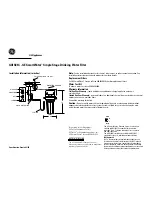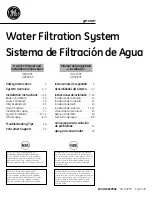
15
Replacement Parts
Model: 415
Model: 525 & 525P
WATTS ITEM#
DESCRIPTIONS
SERVICE LIFE
FPMB5-978
Sediment filter, 5 micron, 10”
6-12 months
F109009
Carbon block filter, 5 micron, 10”
6-12 months
W-1812-50
TFC membrane, 50GPD @ 60 PSI
24-36 months
FI-CBA010J.38
Inline carbon filter
12-18 months
WATTS ITEM#
DESCRIPTIONS
SERVICE LIFE
FPMB5-978
Sediment filter, 5 micron, 10”
6-12 months
F109009
Carbon block filter, 5 micron, 10”
6-12 months
F109009
Carbon block filter, 5 micron, 10”
6-12 months
W-1812-50
TFC membrane, 50GPD @ 60 PSI
24-36 months
FI-CBA010J.38
Inline carbon filter
12-18 months
ARSENIC FACT SHEET
Arsenic (As) is a naturally occurring contaminant found in many ground waters. Arsenic in water has no color, taste or odor. It must be
measured by an arsenic test kit or lab test.
Public water utilities must have their water tested for arsenic. You can obtain the results from your water utility contained with in your
consumer confidence report. If you have your own well, you will need to have the water evaluated. The local health department or the
state environmental health agency can provide a list of test kits or certified labs.
There are two forms of arsenic: pentavalent arsenic (also called As (V), As (+5)) and trivalent arsenic (also called As (III), As (+3)). In well
water, arsenic may be pentavalent, trivalent, or a combination of both. Although both forms of arsenic are potentially hazardous to your
health, trivalent arsenic is considered more harmful than pentavalent arsenic.
RO systems are very effective at removing pentavalent arsenic. A free chlorine residual will rapidly convert trivalent arsenic to pentava-
lent arsenic. Other water treatment chemicals such as ozone and potassium permanganate will also change trivalent arsenic to pen-
tavalent arsenic. A combined chlorine residual (also called chloramine) where it does convert trivalent arsenic to pentavalent arsenic,
may not convert all the trivalent arsenic in to pentavalent arsenic. If you get your water from a public water utility, contact the utility to
find out if free chlorine or combined chlorine is used in the water system.
This Watts Water Quality reverse osmosis system is designed to remove up to 98% of pentavalent arsenic. It will not convert trivalent
arsenic to pentavalent arsenic. Under laboratory standard testing conditions, this system reduced 0.30 mg/L (ppm) pentavalent arsenic
to under 0.010 mg/L (ppm) (the USEPA standard for drinking water). Actual performance of the system may vary depending on spe-
cific water quality conditions at the consumer’s installation. In addition to the independent laboratory standard testing conditions Watts
has conducted additional field testing on our reverse osmosis units to determine trivalent arsenic reduction capabilities. Based upon
Watts field testing, it has been determined that the RO units are capable of reducing up to 67% of trivalent arsenic from the drinking
water.






































